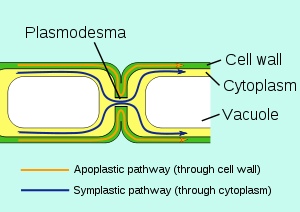Symplast

The symplast of a plant is the inner side of the plasma membrane in which water (and low-molecular-weight solutes) can freely diffuse.
The plasmodesmata allow the direct flow of small molecules such as sugars, amino acids, and ions between cells. Larger molecules, including transcription factors and plant viruses, can also be transported through with the help of actin structures.
This allows direct cytoplasm-to-cytoplasm flow of water and other nutrients along concentration gradients. In particular, it is used in the root systems to bring in nutrients from soil. It moves these solutes from epidermis cells through the cortex into the endodermis and eventually the pericycle, where it can be moved into the xylem for long distance transport. It is contrasted with the apoplastic flow, which uses cell wall transport.
See also
- Apoplast
- Plant sap
- Polar auxin transport, a type of cell-to-cell transport
- Protoplast
- Tonoplast